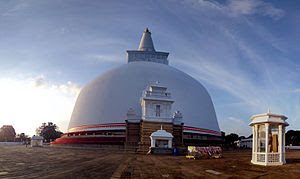Sri Lanka, formerly known as Ceylon, is a country where Buddhism entered very early. Mahavamsa (Great Chronicle) of the island country deals with the history of Buddhism in Sri Lanka. It was during the reign of the great Mauryan emperor Ashoka that Buddhism embarked on a career of world religion.
Sri Lanka was converted to Buddhism in the 3rd century BC by Mahendra (in Pali Mahinda), Ashoka’s son or his brother by some sources, during the reign of great king Devanampiya - Tissa, who was Mahendra’s first convert. Mahendra had become a Buddhist monk.
Asoka’s daughter Sanghamitta
is said to have carried to Sri Lanka the southern branch of the original Bodhi
tree of Gaya, under which the Buddha sat and got enlightenment. From then, this
tree planted at Anuradhapura, capital of the early kings of Ceylon, has been an
object of pilgrimage to the followers of Buddhism in Sri Lanka.
The Buddhist stupas of
gigantic proportions were built in Sri Lanka. 327 feet in diameter, the
Abhayagiri Dagaba at Anuradhapura was larger than some of the pyramids of the
Egypt. Another stupa at Anuradhapura,
the Ruwanmalisaya Dabaga, used by the Buddhist as a place of worship, rises
white in the distance out of the plain and is a marvel to look at.
Pali, one of the early
Prakrit languages, is the religious language of the Buddhist in Sri Lanka.

Comments
Post a Comment